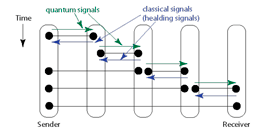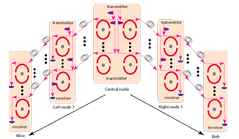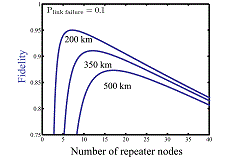
Subject A : Quantum repeaters and their node technology
158A-T01Quantum repeater network system architecture and node device requirements
National Institute of Informatics (Kae Nemoto)
This project aims to theoretically construct quantum repeater architectures for quantum communications over 50km to 3000km. To realize such quantum repeater systems, quantum devices at each node need to be constructed and evaluated to identify their requirements. To evaluate quantum repeater as a quantum information system, we develop evaluation methods for quantum repeater system and estimate the quantum repeater designs developed in this project.
- 1. System design for quantum repeaters
We proposed quantum repeater architectures for the communication length 50 km to 3000km. We first showed a linear quantum repeater architecture for less than 100km with the Bell pair fidelity of 70%, and showed how such a primitive quantum repeater system can be scaled up to fully fault-tolerant communication system. To extend a linear system to arbitrary quantum networks, we constructed memory-based quantum repeater design and memoryless quantum repeater design as shown in Fig. 1 and 2.
 Nature Photonics, Vol. 6, No.11, pp.777-781 (2012)
Nature Photonics, Vol. 6, No.11, pp.777-781 (2012) Physical Review A, Vol. 87, Issue 5, 052333 (2013)
Physical Review A, Vol. 87, Issue 5, 052333 (2013)

Fig. 2Quantum memoryless repeater scheme allow the quantum devices at its full capability as there is no waiting time required in its operation. This makes rate quantum communication possible.
- 2. Quantum repeater node technology
We designed quantum devices for quantum repeater nodes and evaluated the requirements to implement quantum repeater at each stage of development. Quantum protocols and quantum devices are both necessary node technology at quantum repeater node. As a promising candidate for quantum devices, we focused on Diamond NV centers. We designed a quantum repeater module with a single NV center and an optical cavity. Using this model, we designed and improved quantum protocols for entanglement distribution. (Fig. 3)
 Phys. Rev. A, Vol. 88, 060301(R) (2013)
Phys. Rev. A, Vol. 88, 060301(R) (2013) Phys. Rev. X, Vol. 4, 031022 (2014)
Phys. Rev. X, Vol. 4, 031022 (2014) Phys. Rev. A, Vol. 94, 022320 (2016)
Phys. Rev. A, Vol. 94, 022320 (2016)

Fig. 3The top schematic figure shows the basic design for the NV-based quantum repeater device and the entanglement distribution protocol, whereas the bottom figure shows the entanglement distribution protocol improved for a long distance.
- 3. System evaluation for quantum repeaters
To evaluate the performance of quantum repeater systems and compare them, we need to develop a system evaluation framework for quantum repeaters based on different node technologies and quantum repeaters at different development stages. Considering several key system elements: scalability, resource, fidelity, rate, waiting time, and integratability, we developed integrated evaluation frame for quantum repeaters. We apply it to the quantum repeater designs developed in this project and showed their advantages.
 Scientific Reports 6, 26284 (2016)
Scientific Reports 6, 26284 (2016)



